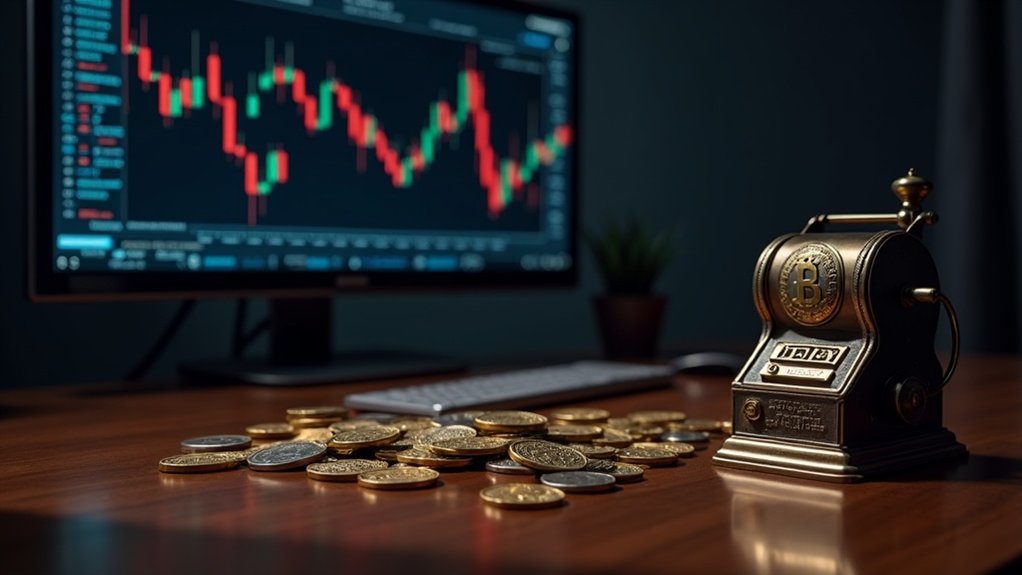Crypto derivatives are financial contracts that get their value from underlying cryptocurrencies. They include futures, options, perpetual contracts, and swaps. Traders use them to speculate on price movements without owning actual crypto or to hedge against market volatility. They work through leverage, allowing control of larger positions than your actual balance. Yeah, they’re useful in both bull and bear markets. Not for the faint-hearted though—one wrong move and liquidation comes knocking.
While traditional finance has long dabbled in complex instruments, cryptocurrency markets have evolved far beyond simple buying and selling. Enter crypto derivatives – financial contracts that derive value from underlying crypto assets without requiring ownership of the actual coins. They’re like betting on a horse without having to feed it. Traders use these instruments to speculate on price movements or hedge their existing portfolios against market volatility.
The derivatives landscape isn’t exactly simple. Futures contracts commit traders to buy or sell crypto at predetermined prices on specific dates. Options, meanwhile, offer more flexibility – the right but not the obligation to execute a trade. There’s a reason options traders sleep better at night. Perpetual contracts (or “perps” as the cool kids call them) function like futures without expiration dates, using funding rates to keep prices aligned with spot markets. Similar to yield farming strategies, these instruments provide various ways to generate returns in the crypto market. Swaps round out the offerings, allowing parties to exchange different types of cash flows or assets.
Dive into derivatives, but mind the complexity. These financial sharks will test your trading mettle.
These contracts pack a punch. Traders can go long when they’re feeling bullish or short when the market outlook seems grim. Many platforms offer leverage, allowing control of positions far larger than actual account balances. Great when prices move your way. Absolutely devastating when they don’t. The settlement process can occur through physical delivery or cash methods, making transactions more streamlined.
The appeal is obvious. Derivatives provide ways to profit in both rising and falling markets. They enable sophisticated hedging strategies for risk management. Arbitrage opportunities emerge between spot and derivatives markets. And the leverage? That’s the siren song that’s lured many a trader to financial ruin.
Make no mistake – these aren’t instruments for the faint-hearted. Market volatility can trigger cascading liquidations faster than you can say “margin call.” The complexity demands significant knowledge. Yet derivatives serve important market functions – enhancing liquidity, aiding price discovery, and allowing customized risk exposure.
They’re powerful tools. They’re also perfect mechanisms for spectacular financial implosions. Just another day in crypto.
Frequently Asked Questions
What Are the Tax Implications of Trading Crypto Derivatives?
Crypto derivatives traders face capital gains taxes on profits.
Short-term gains (held under a year) get taxed at regular income rates—up to 37%. Long-term positions enjoy lower rates of 0-20%.
Losses can offset gains plus $3,000 of other income.
Starting 2025, brokers must report transactions on Form 1099-DA. Non-custodial exchanges? No reporting requirements.
Wallet-by-wallet accounting becomes mandatory soon.
Tax rules keep changing. The IRS wants its cut, obviously.
How Do Crypto Derivatives Impact Overall Market Volatility?
Crypto derivatives amplify market volatility through leveraged trading that magnifies price swings.
Futures and options markets create volatility dynamics distinct from spot markets. When traders pile into leveraged positions, liquidation cascades can trigger violent price movements.
Ironically, while derivatives enable hedging, they often end up destabilizing markets.
Volatility feedback loops emerge: derivatives cause price swings, which trigger liquidations, causing more volatility.
The data’s clear – derivatives volumes now dwarf spot trading, making the tail wag the dog.
Can Beginners Safely Engage in Crypto Derivatives Trading?
Beginners and crypto derivatives? Not a great mix. The complexity alone is a minefield.
High leverage can wipe out investments faster than you can say “liquidation.” Most newbies lack the knowledge to navigate funding rates, contract structures, and volatile market swings.
Plus, there’s the whole counterparty risk thing. Exchanges get hacked. Platforms go bust. Even experienced traders get burned regularly.
The learning curve is steep, and the consequences of mistakes? Brutal.
What Security Measures Protect Traders on Derivatives Platforms?
Crypto derivatives platforms protect traders through layered security systems.
Cold storage wallets keep most funds offline—hackers can’t touch what isn’t connected. Two-factor authentication stops account breaches, while multi-signature wallets require multiple approvals for withdrawals.
DDoS protection prevents service disruption. Encryption shields sensitive data. Regular security audits catch vulnerabilities. Some platforms even offer insurance policies—though good luck collecting if something catastrophic happens.
Ultimately, security is robust but never perfect.
How Do Regulatory Changes Affect Crypto Derivatives Markets?
Regulatory changes impact crypto derivatives markets in profound ways.
The CFTC’s withdrawal of 2018 guidance signals less hand-holding for exchanges. Meanwhile, AML/KYC requirements remain non-negotiable—nobody’s escaping those checks.
The White House is trying to move beyond “regulation by enforcement” toward actual frameworks. Makes sense.
These shifts are reshaping institutional participation, with clearer rules potentially attracting bigger players.
Bottom line: regulation dictates who plays, how they play, and ultimately, market growth potential.









